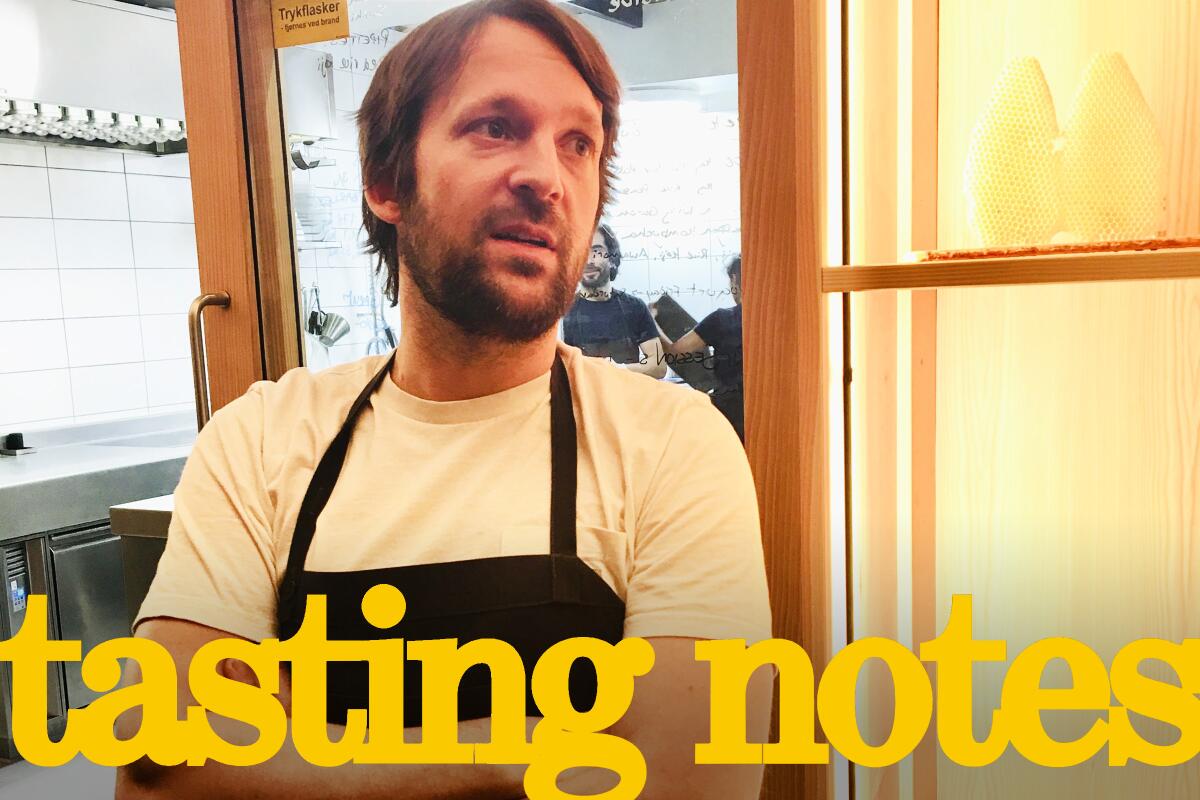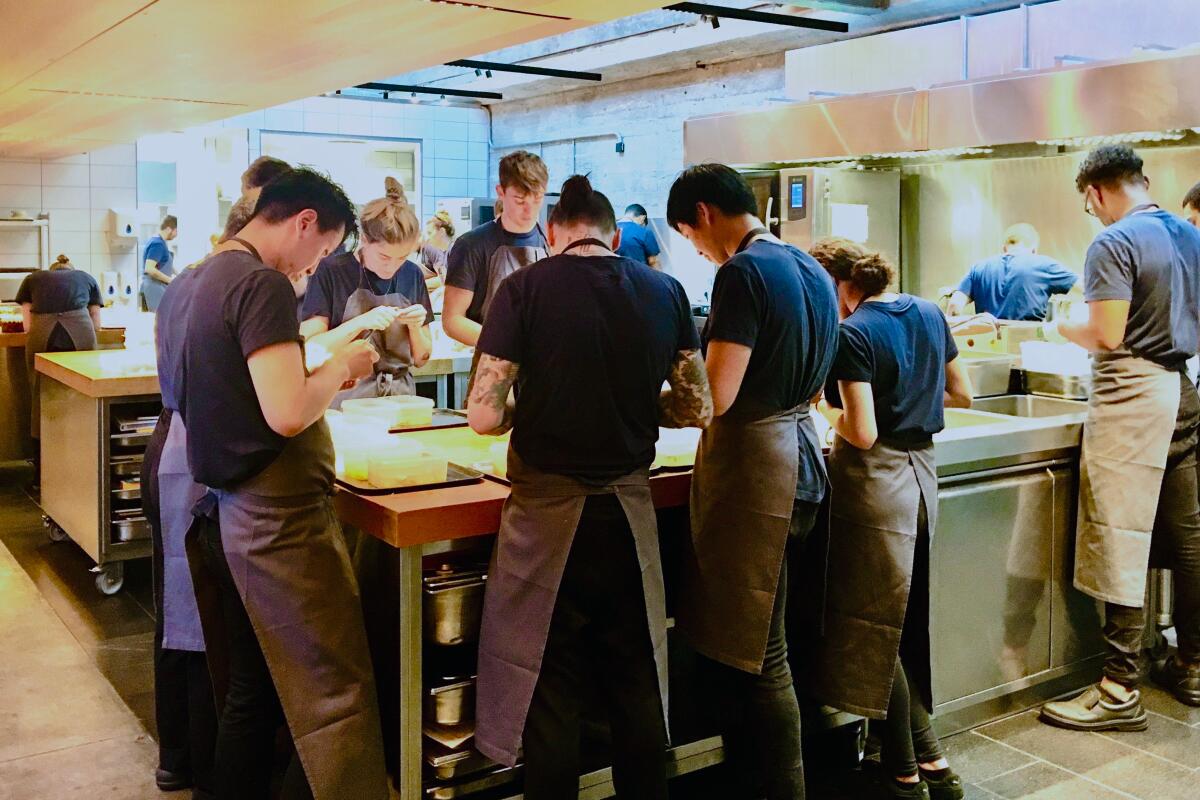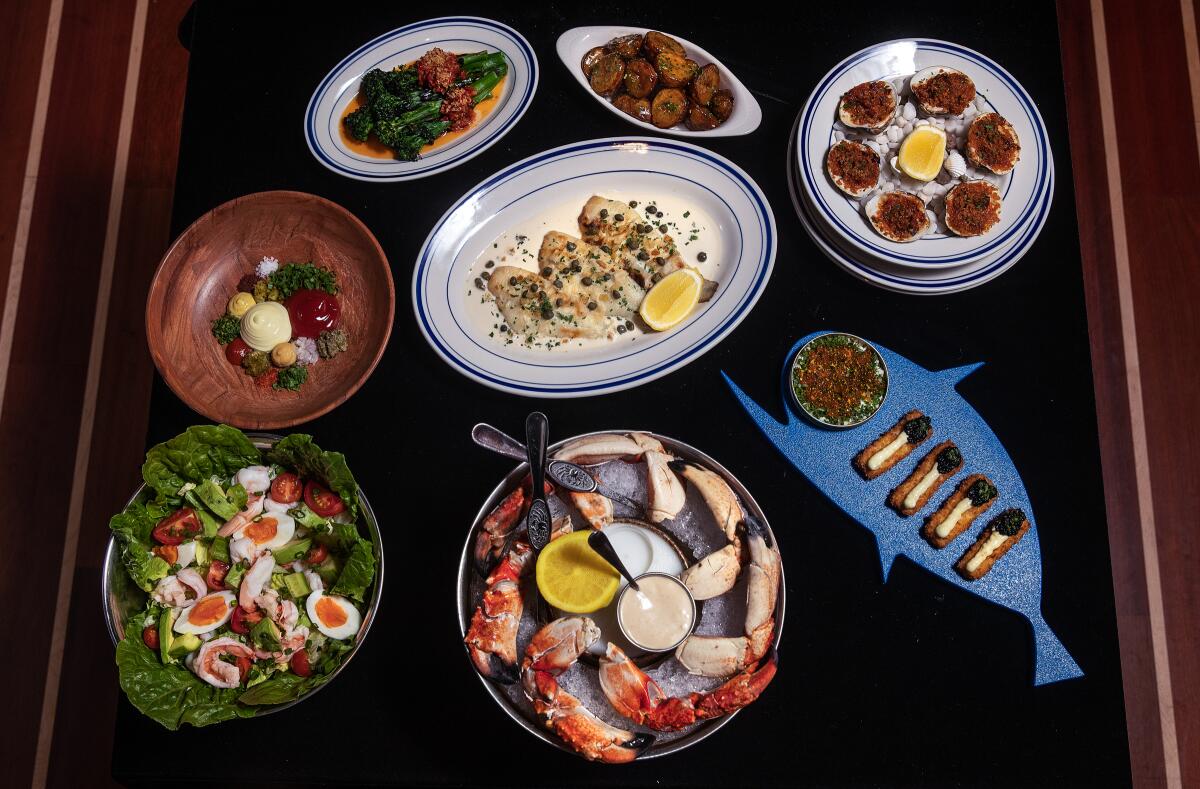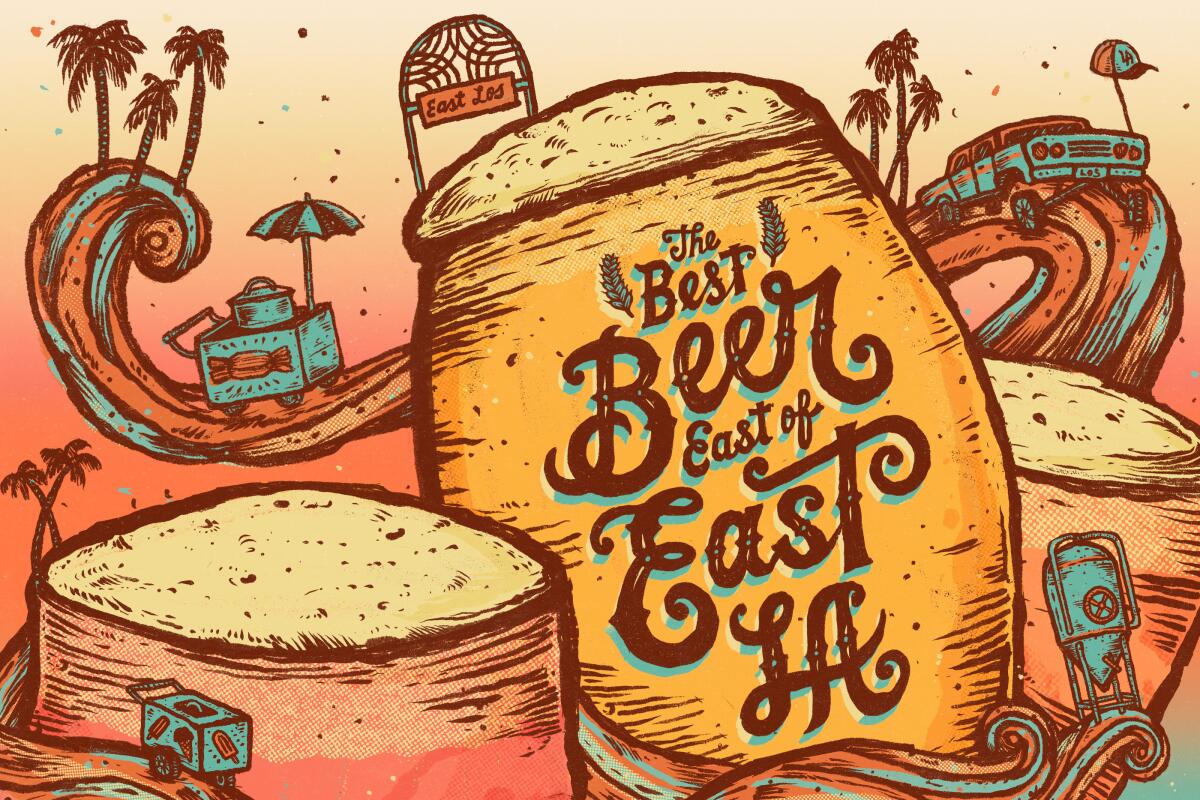Does Rene Redzepi closing Noma really mean the end of fine dining?

- Share via
An Eastside craft brewery scene, Walmart pink sauce, a ceviche hangover cure and rice bags as sandbags. I’m Laurie Ochoa, general manager of Food, with this week’s Tasting Notes.
Fine dining’s twilight?

In the days since Rene Redzepi announced that he’ll close his Copenhagen restaurant Noma nearly two full years from now, there’s been a lot of talk about the unsustainable nature of fine dining, often punctuated with a jolt of glee or apology (depending on whether you have or would never spend money on a tasting menu) fueled by the recent pop culture trend to portray chefs as murderous tyrants or burnt-out tyrants.
At moments it felt as if everyone was channeling Ebon Moss-Bachrach‘s Richie in “The Bear” when he tells fine-dining refugee Carmy (Jeremy Allen White), “Oh, and f— your Noma too!”
Does fine dining have to end with Noma?
Here in Los Angeles, many chefs, even at some smaller, neighborhood restaurants, are finding that the tasting menu format employed by so many Michelin-starred and “World’s Best” restaurants like Noma is actually a way for them to stay in business.
“There is no guesswork to it,” Ryan Wong, chef and co-owner of Silver Lake’s Hong Kong-influenced Needle restaurant told Jenn Harris in a story last year about why so many chefs are turning to tasting menus. “We can prepare what we need to prepare, there is less food waste because we are not over-prepping, and it helps us to manage our workload.”
Harris wrote that for Minh Phan, who at the time was running the tasting-menu-focused Phenakite at Second Home, “serving fewer guests, fewer times a week at a higher price point, created a better work-life balance for [the chef] and her staff.”
Of course, there is the question of whether diners can afford to eat at restaurants that feature tasting menus. Some balk at the number of courses served during what can typically be a three-hour experience. And, as many have discussed, there is a high personal toll that staffers pay when they perform high-stress restaurant work.
These are issues that have long troubled Redzepi. At the 2016 edition of the Noma-founded MAD Symposium in Copenhagen — a year before the 2017 revelations about producer Harvey Weinstein that set off the #MeToo movement across multiple industries — Redzepi and his team hosted talks at the chefs’ gathering where hard questions were asked about the abuse, sexism, addiction problems and harassment faced by so many in the restaurant industry. This took place a year after Redzepi admitted in a 2015 essay for Lucky Peach that he’d been “a terrible boss.” “I’ve been a bully for a large part of my career,” he wrote. “I’ve yelled and pushed people.” And then he asked, “How do we unmake the cultures of machismo and misogyny in our kitchens? ... Do we want to be better?”
In his efforts to be better, Redzepi has gone to great pains to create a work-life balance for his staff. Yet given some of the stories about the unpaid interns who powered Noma (the restaurant only recently began paying interns), it’s clear that he and the restaurant fell short at times.
I’ve been lucky enough to have eaten at Noma several times — in Copenhagen as well as at the Noma pop-ups in Tokyo and Tulum, and a night here in Los Angeles. One of the most striking things about the experience is how much the people who work at Noma made the experience better. It wasn’t just about the food or Redzepi, but the servers who generously shared their knowledge and the cooks who graciously took the time to show guests Noma’s behind-the-scenes spaces, including the famous fermentation lab and built-in ant farm.
Enjoying this newsletter? Consider subscribing to the Los Angeles Times
Your support helps us deliver the news that matters most. Become a subscriber.
From my privileged perspective as a diner, Noma is not the solemn, reverential restaurant parodied in the horror film “The Menu,” but a playful place where experimentation is encouraged and many different chefs contribute ideas that shape what appears on the menu. The cooks and servers I met seemed eager to wow us with new flavors and stories behind the ingredients. Yes, sometimes a lone piece of seafood was served on a rock, as we saw caricatured “The Menu,” but at Noma the food was presented with delight and frequently humor.
Of course, we can never know as restaurant diners what really happens inside the kitchens run by famous chefs. Even when some of those kitchens are open to the dining room and we can watch the choreography of chefs in motion, we miss a lot. But what shouldn’t be missed is what all those chefs in Noma’s kitchen created together as a team: beautiful, challenging food that’s helped the industry keep its focus on local, seasonal food and inspired a generation of chefs to think differently about what is possible.
I hope that Noma’s transition from a full restaurant to a food lab and pop-up operation doesn’t really mean the end of fine dining as many have been predicting. We need to make better work lives for the people who feed us, but we shouldn’t lose sight of the talent coming out of our restaurant kitchens and bringing us delicious things to eat.
Sea bounty at Dear Jane’s

In his review of Dear Jane’s in Marina del Rey, restaurant critic Bill Addison gets nostalgic for the Chart House, the chain that used to have one of its prime locations in the space now occupied by the seafood-based sister restaurant to the steakhouse Dear John’s from chef Hans Röckenwagner, his wife and marketing executive Patti Röckenwagner, and Mélisse and Citrin chef Josiah Citrin. It happens to be a place that my mother used to eat at in her dating days — which meant steak leftovers the next morning for my sister and me.
Eat your way across L.A.
Get our weekly Tasting Notes newsletter for reviews, news and more.
You may occasionally receive promotional content from the Los Angeles Times.
“Faraway memories lit up my brain with two words: Chart House,” Addison writes. “There was a location of the higher-end seafood chain — which was founded in 1961 and based for years in San Diego — in Baltimore’s Inner Harbor. My family went a couple of times for special occasions. Sure enough, the Dear Jane’s space was previously a Chart House outpost.”
The Chart House was always one of those restaurants that, like Fiasco, also in the Marina, epitomized the ’70s singles scene. Outside of her dating life, my mother would occasionally take my sister and me to these restaurants, but I mostly experienced the Marina scene through television — it made a great backdrop for TV cops chasing some wealthy boat-owning bad guy and, of course, was home base for Jack Klugman‘s Quincy.
Craft beer east of East L.A.

Melissa Mora Hidalgo writes our L.A. Times Food cover story in this Sunday’s Weekend section on the craft beer movement that has matured east of East L.A. in the days since this paper published a craft beer guide in 2015. “Back then, there was a huge gap on the region’s brewery map: the Greater Eastside of L.A.,” she writes. “That gap has been filled.” The region’s burgeoning brewery scene. is one of the most exciting in the state, with beers that are earning awards for their “innovative beers ranging from classic styles to experimental brews and trendy seltzers.” Mora Hildalgo also writes an essay about her “Budweiser man” grandpa and the family tour of the Olympia Brewery in Tumwater, Wa., that sparked her fascination with beer making. “Watching the brewery action was almost like watching the opening credit sequence of ‘Laverne & Shirley’ in real life, and my dad and grandpa were right in the middle of it like Lenny and Squiggy. “
Have a question?
Monarch’s Hong Kong cuisine

Stephenie Breijo talks with the family behind Chifa in Eagle Rock and their new place Monarch in a former noodle shop in Arcadia. Co-owner and fashion designer Humberto Leon tells Breijo that “the family sees the Monarch menu as an exploration of the current state of Hong Kong trends and styles, playing with modern flavors as well as the diner-like hallmarks of cha chaan teng — a beloved variety of the region’s cafes.” Definitely a place. to check out.
— Breijo also has a full rundown of the week’s restaurant opening news, including details about Sundays the Bakery from “the maker of some of L.A.’s best breakfast burritos.”
Walmart and the pink sauce deal
You saw it on TikTok, or at least heard the pro and con discussions, now Miami’s Chef Pii, a.k.a. Veronica Shaw, has unleased pink sauce for the masses through a distribution deal with Walmart. “It’s a Willy Wonka-meets-Cinderella type of story,” said David Neuman, president and CEO of Dave’s Gourmet, who helped Shaw bring the dragon-fruit-based sauce to market. “You know, mad scientist with an idea figures out how to get that product made and sold nationally and comes out smelling like a rose.” Food reporter Astrid Kayembe also talked with Shaw about the deal, “I wanted a unique sauce. I wanted something that tasted like nothing else, but also to have a natural bright color,” she said, “and I was able to accomplish that.”
Also ...
— Astrid Kayembe teamed up with Food’s Stephanie Breijo to report on how the rain affected business at Southland restaurants with the detail that Filipinotown‘s Woon got through the deluge by using 50-pound bags of rice as sandbags.
— For those who aren’t quite making it through Dry January, Jenn Harris gets an excellent suggestion from Ceviche Stop chef and owner Walther Adrianzen: the Hangover. It’s a tall malt glass “overflowing,” Harris writes, “with chopped striped bass swimming in leche de tigre. On top is a heap of fried calamari and on the very top, a stack of fried yuyo, a seaweed Adrianzen sources from Peru.” “Usually in Peru,” the chef tells Harris, “when people drink, we have these cevicherias open 24/7,” he said. “Let’s say you’re drunk, you go get your ceviche and then you just keep going with the party.” Well, OK!
Eat your way across L.A.
Get our weekly Tasting Notes newsletter for reviews, news and more.
You may occasionally receive promotional content from the Los Angeles Times.




